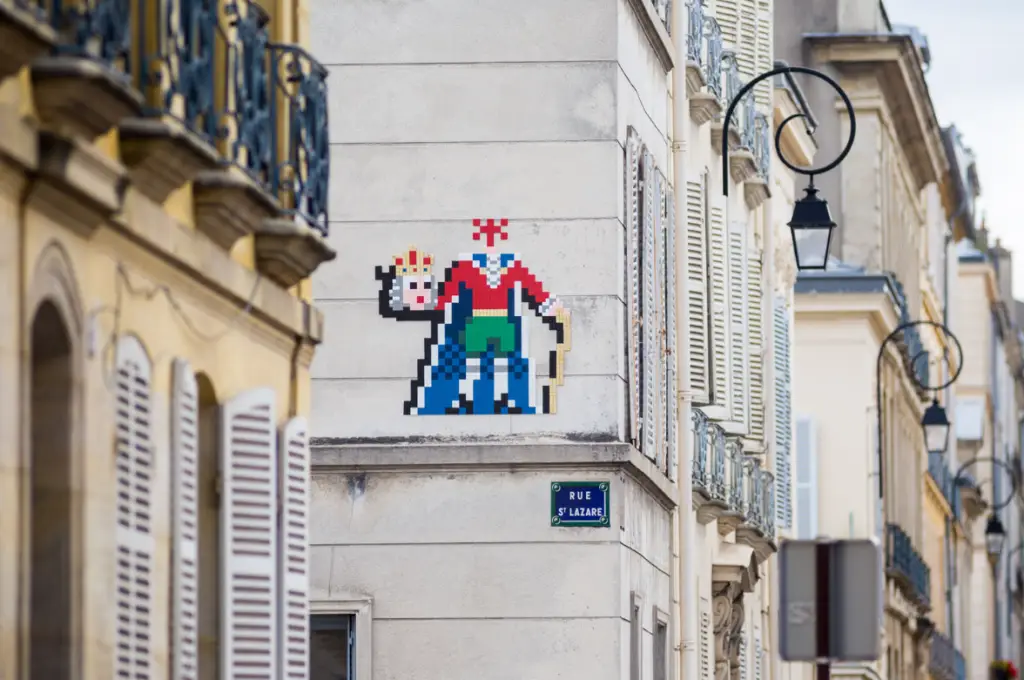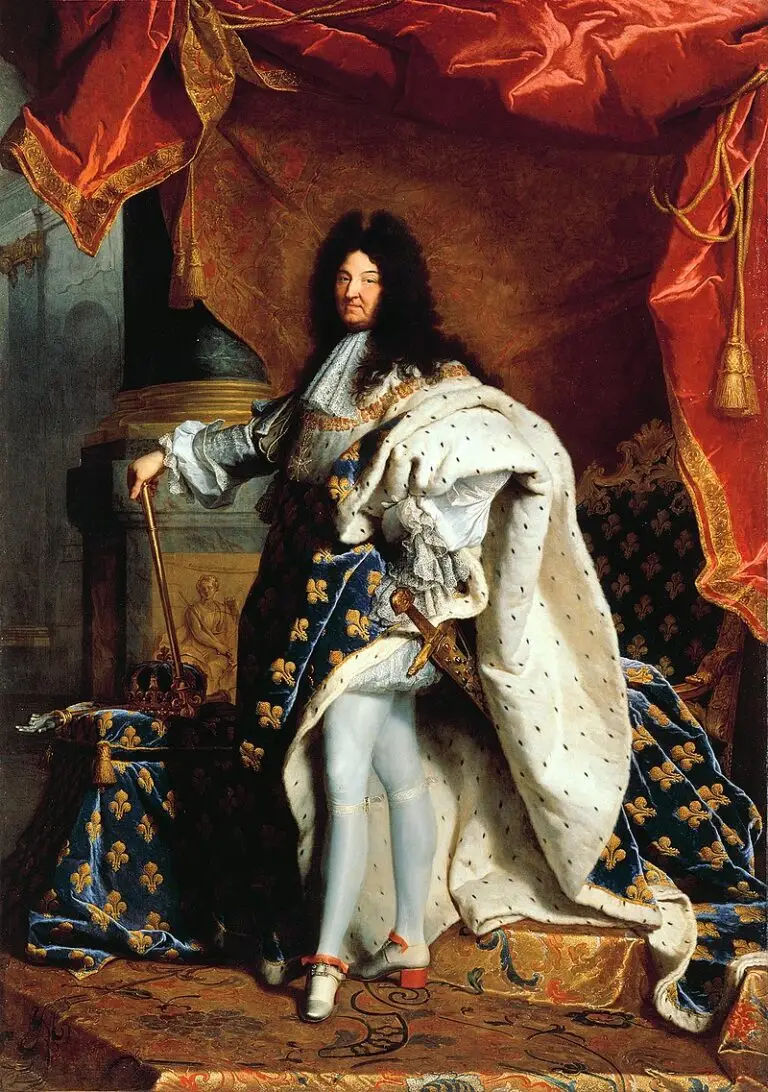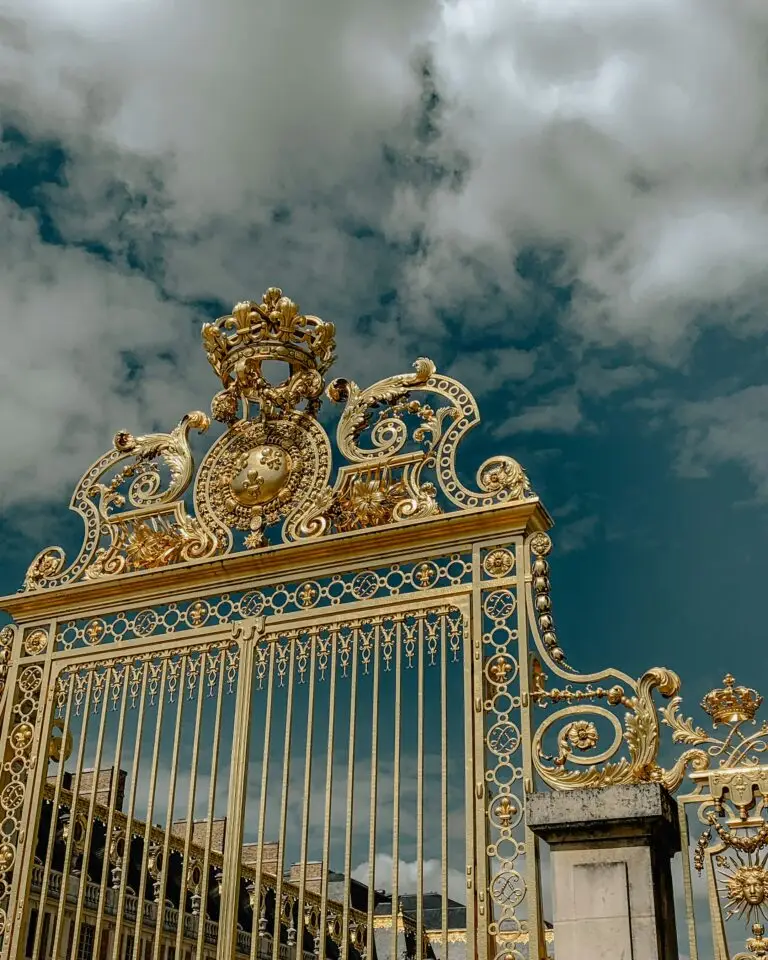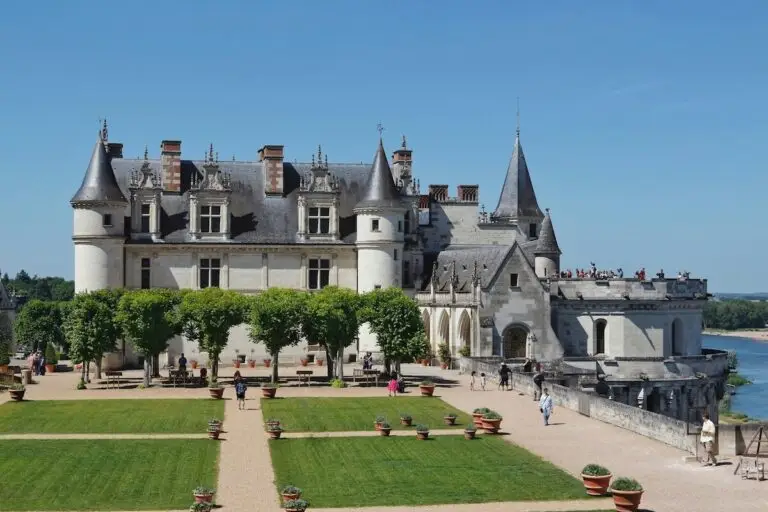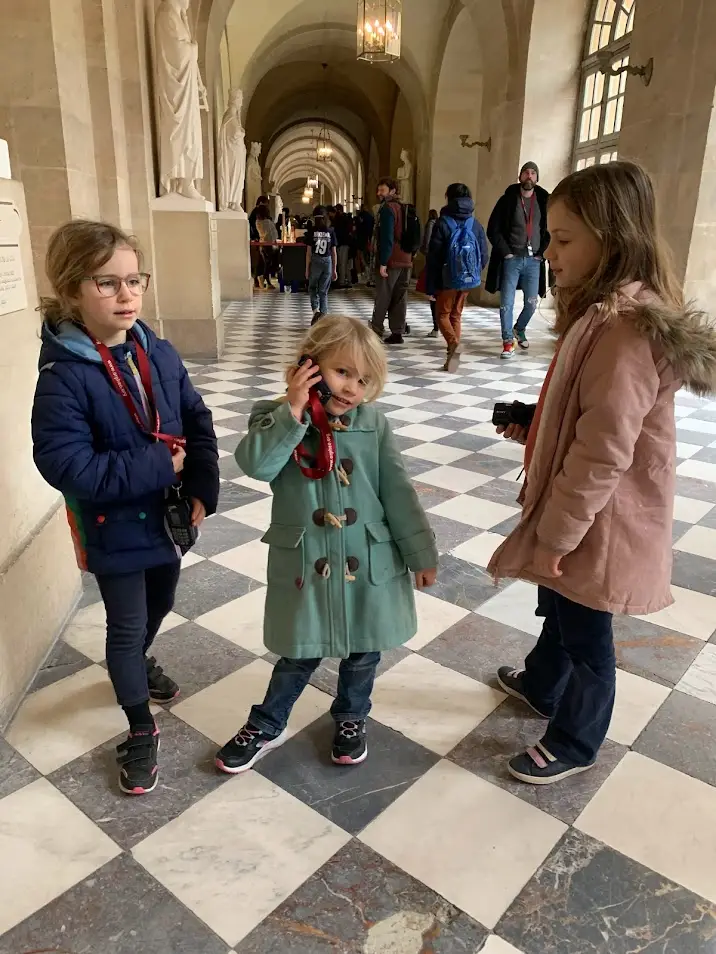Welcome to the Palace of Versailles, one of the most famous places in French history.
This guide is all about the history of Versailles for kids, filled with fun facts, amazing stories, and jaw-dropping rooms built for kings and queens. From sparkling mirrors to secret gardens, you’re about to explore a royal wonder that helped shape the history of France—and the whole world!
The Magnificent Palace of Versailles: France’s Royal Wonder
Imagine a palace so enormous that walking through all its 700 rooms would take more than an hour! The Palace of Versailles (Château de Versailles) in France stands as one of history’s most extraordinary royal residences.
With its gold-covered statues, breathtaking Hall of Mirrors, and gardens stretching as far as the eye can see, Versailles was designed to leave visitors speechless.
But how did this incredible palace evolve from humble beginnings, and what role did it play in the dramatic French Revolution?
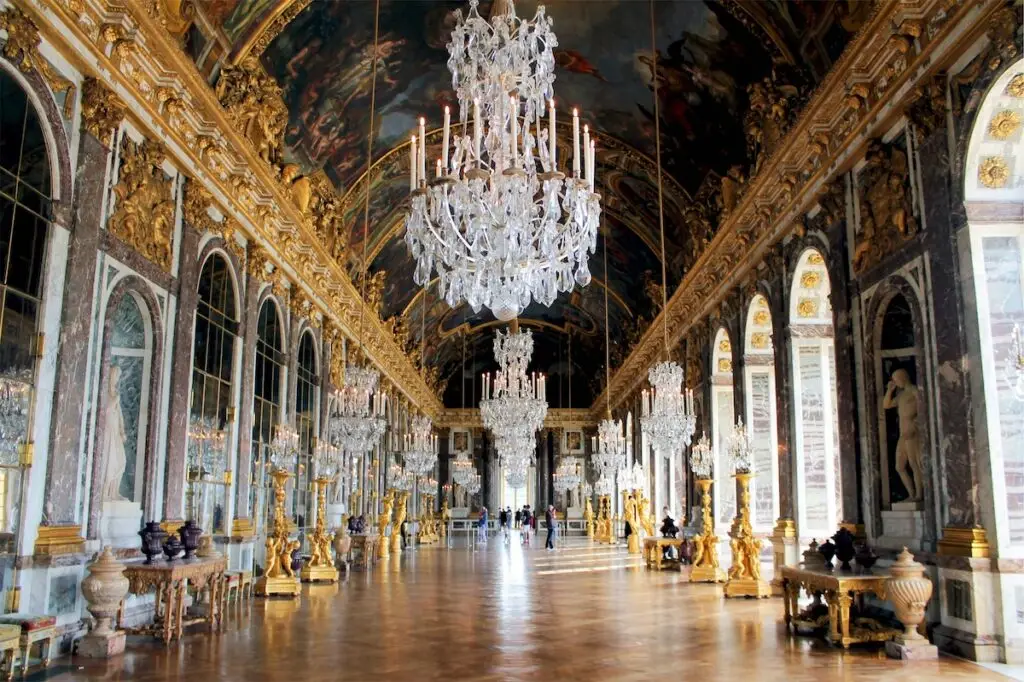
From Simple Hunting Lodge to Royal Palace (1623-1661)
In 1623, the forests near Paris were great for hunting, and King Louis XIII loved them. He built a small brick and stone lodge in the village of Versailles, about 12 miles from Paris, so he could rest after hunting deer and wild boar. His hunting lodge was a quiet escape from the busy, noisy city.
Over time, Louis XIII became increasingly fond of his hunting retreat. He gradually expanded the building, adding several rooms and improving its appearance. The king’s architect, Philibert Le Roy, helped transform the lodge into a small château surrounded by a moat.
Despite these improvements, it remained relatively modest compared to other royal residences like the Louvre Palace in Paris. No one could have predicted that this simple structure would become the foundation for the world’s most famous palace.
The Sun King’s Grand Vision (1661-1715)
Everything changed dramatically in 1661 when Louis XIV, son of Louis XIII, took the throne. The young king, who called himself the “Sun King” (Le Roi Soleil), had ambitious plans. He wanted to create a palace that would showcase France’s power, wealth, and artistic excellence to the entire world.
The transformation began gradually. First, Louis XIV preserved his father’s hunting lodge as the central part of his new palace while expanding outward. He hired France’s greatest architects, including Louis Le Vau and Jules Hardouin-Mansart, to design the expansions. The famous landscape architect André Le Nôtre created the extraordinary gardens, while painter Charles Le Brun decorated the palace interiors with breathtaking artworks celebrating the king’s glory.
By 1682, the palace had become so impressive that Louis XIV officially moved his entire government and royal court from Paris to Versailles. This bold move brought thousands of nobles, servants, and government officials to live and work at the palace. The small hunting lodge had grown into the beating heart of the French kingdom and the center of European politics.
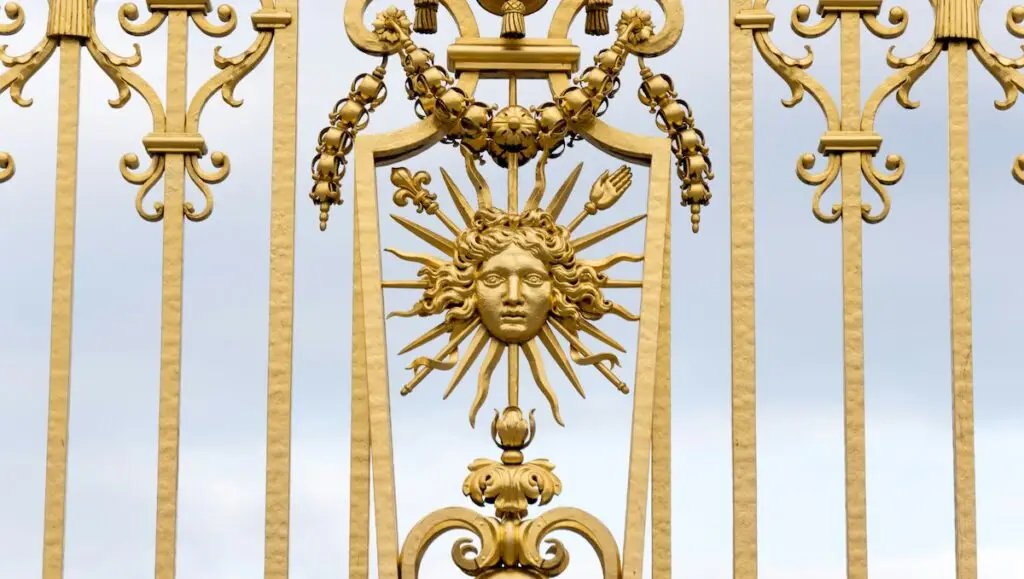
a radiant emblem of Louis XIV crowns the golden gates of Versailles.
Building a Palace Fit for the Sun King
The construction of Versailles ranks among history’s most ambitious building projects, lasting for several decades and employing up to 36,000 workers at its peak. These laborers dug massive foundations, quarried stone from throughout France, and created elaborate systems to bring water to the palace and its hundreds of fountains.
One of the biggest challenges involved supplying water to the gardens and fountains. Since Versailles had no natural water source nearby, engineers constructed an enormous pumping system called the Machine de Marly to bring water from the Seine River. This used 14 water wheels and 221 pumps to lift water 502 feet uphill through a series of pipes. The machine was so complex and impressive that people traveled from across Europe just to see it in real life.
Inside the palace, artists and craftsmen worked tirelessly to create painted ceilings, intricate wood carvings, and lavish decorations. The most famous room, the Hall of Mirrors (Galerie des Glaces), featured 357 mirrors at a time when mirrors were extremely rare and expensive. The hall stretched for 240 feet, with 17 arched windows on one side matched by mirror-covered arches on the opposite wall. When filled with candlelight for evening gatherings, the effect was simply magical.
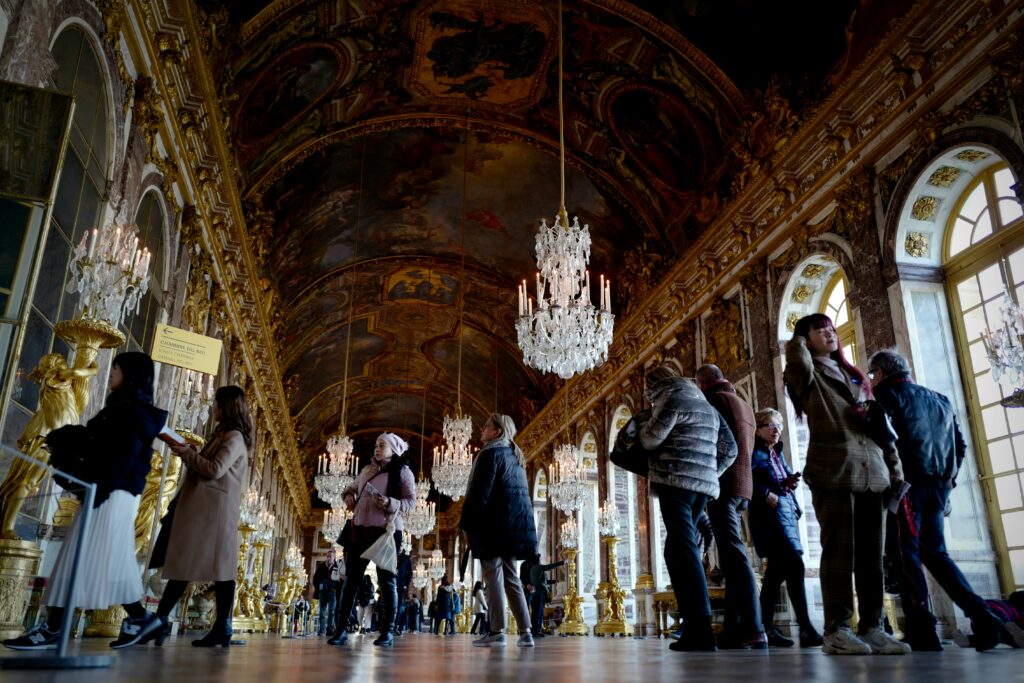
Daily Life at Versailles Under Louis XIV
Louis XIV transformed daily life at Versailles into an elaborate performance governed by strict etiquette. Every moment of the king’s day followed precisely timed ceremonies known as “les étiquettes.”
When the king awoke, high-ranking nobles competed for the honor of participating in the “lever du roi” (the king’s rising) ceremony, where they would help him dress.
When he dined, courtiers watched in respectful silence during the “grand couvert” (formal dinner). Even bedtime became a formal ceremony called the “coucher du roi,” with specific nobles assigned to hold candles or carry royal items.
The king created these ceremonies for political purposes. By keeping nobles occupied with palace duties and ceremonies, he prevented them from developing independent power bases in their home provinces. Nobles who might have challenged the king’s authority were instead competing for the privilege of holding the royal napkin at dinner!
At its height, Versailles housed around 10,000 people, including the royal family, aristocrats, government officials, servants, and guards. The palace complex grew to include separate buildings for government offices, servants’ quarters, royal stables that could house 2,000 horses, and various workshops. A small city developed around the palace to support the thousands of people needed to keep Versailles functioning smoothly.
By the time Louis XIV died in 1715 after a record-breaking 72-year reign, Versailles had become the model that other European rulers sought to emulate, though none ever matched its scale or splendor.
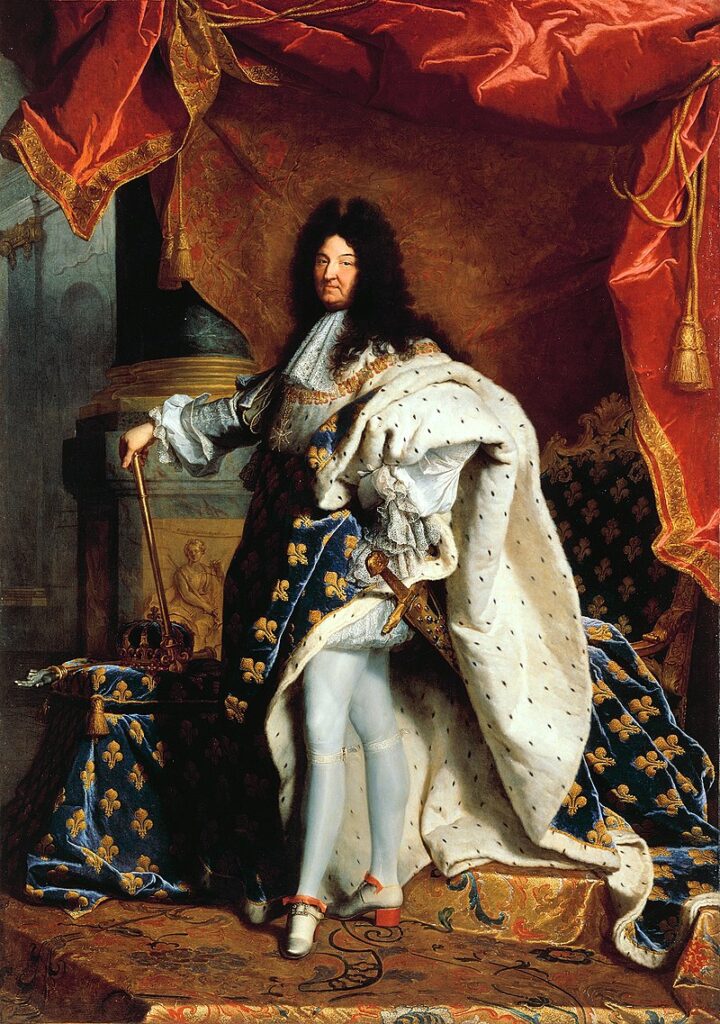
Versailles After Louis XIV (1715-1774)
Louis XV, the great-grandson of Louis XIV, inherited the throne in 1715 and continued developing Versailles. While he didn’t substantially enlarge the palace, he redecorated many rooms in the fashionable Rococo style, which featured lighter colors, more delicate designs, and nature-inspired motifs that contrasted with the bold, formal decorations of Louis XIV’s baroque era.
Louis XV created more intimate, comfortable spaces within the massive palace complex. The most famous addition was the Petit Trianon, a smaller palace on the grounds where the king could escape the rigid etiquette and public ceremonies of the main palace.
He also constructed a magnificent royal opera house, designed by Ange-Jacques Gabriel, that could seat 700 people. This architectural masterpiece featured special machinery that could quickly change scenery during performances.
Despite these impressive improvements, serious problems were developing throughout France. The enormous cost of maintaining Versailles, supporting the luxurious court lifestyle, and paying for expensive wars left the country with mounting debts.
While the king and nobles enjoyed luxury at Versailles, ordinary French citizens struggled with high taxes and food shortages. These problems would only worsen during the next reign.
Marie Antoinette and Louis XVI at Versailles (1774-1789)
When Louis XVI became king in 1774 at the age of 19, he inherited both the beautiful Versailles and France’s escalating financial crisis. His young Austrian wife, Marie Antoinette, found the strict rules and constant scrutiny of court life at Versailles suffocating.
The queen took over the Petit Trianon that Louis XV had built, transforming it into her personal sanctuary where she could escape the watchful eyes and gossip of the court. Marie Antoinette created her own private world at Versailles. In 1783, she commissioned the construction of a rustic village called the Hameau de la Reine (The Queen’s Hamlet) near the Petit Trianon.
This picturesque model farm included thatched cottages, a working dairy, a mill, and gardens where the queen and her close friends could dress as shepherdesses and play at rural life. The village had real farm animals and vegetables tended by actual farmers, but it served primarily as an elaborate escape for the queen. While Marie Antoinette was playing at being a simple country girl, real French farmers were struggling to grow enough food to feed their families.
The stark contrast between the opulent lifestyle at Versailles and the hardships faced by ordinary French people became increasingly difficult to ignore. The royal family continued to spend enormous sums maintaining their way of life while the country’s financial situation grew desperate.
Change was becoming inevitable.
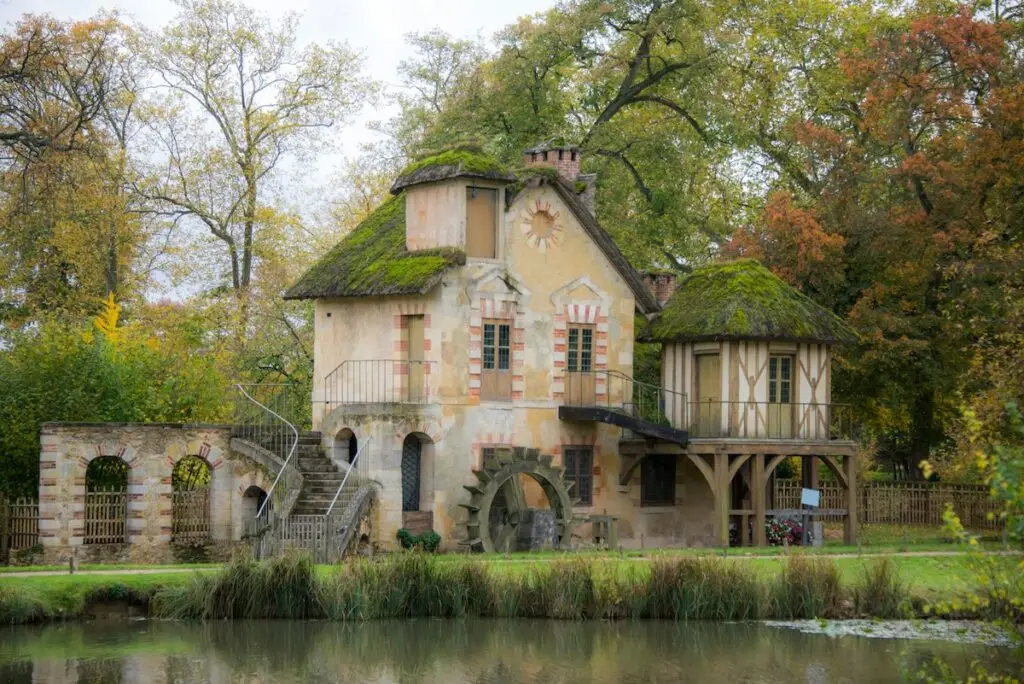
Revolution Comes to Versailles (1789)
By 1789, France faced a severe crisis. Years of poor harvests had led to food shortages and rising bread prices, while the government teetered on the edge of bankruptcy. In a last attempt to address these problems, King Louis XVI summoned a meeting of representatives from France’s three estates (clergy, nobility, and commoners) known as the Estates-General. This gathering, the first since 1614, was held at Versailles in May 1789.
Rather than solving France’s problems, the meeting marked the beginning of the French Revolution. The representatives of the Third Estate (the commoners) formed a new National Assembly and demanded fundamental changes to France’s government and society. In Paris, revolutionaries stormed the Bastille prison on July 14, 1789, a date now celebrated as France’s national holiday.
The situation reached a critical point on October 5, 1789, when thousands of Parisians, mostly women market workers, marched the 12 miles from Paris to Versailles in what became known as the Women’s March on Versailles or the October Days. They were angry about bread shortages and rumors that the royal family was feasting while people starved. The crowd broke into the palace, killed several guards, and nearly reached Marie Antoinette’s bedroom before she escaped to the king’s apartments.
The next day, the crowd surrounded the palace and demanded that the royal family return to Paris. King Louis XVI appeared on a balcony and agreed to their demands. Later that same day, the royal carriages departed Versailles with the king, queen, and their children, followed by a procession of market women, National Guard soldiers, and revolutionaries carrying loaves of bread on pikes.
The royal family would never see their magnificent palace again. They were kept under guard at the Tuileries Palace in Paris for two years before attempting to flee the country in 1791. After their failed escape, they were sent to prison. In 1793, both Louis XVI and Marie Antoinette were executed by guillotine (had their head chopped off!) during the violent phase of the revolution known as the Reign of Terror.
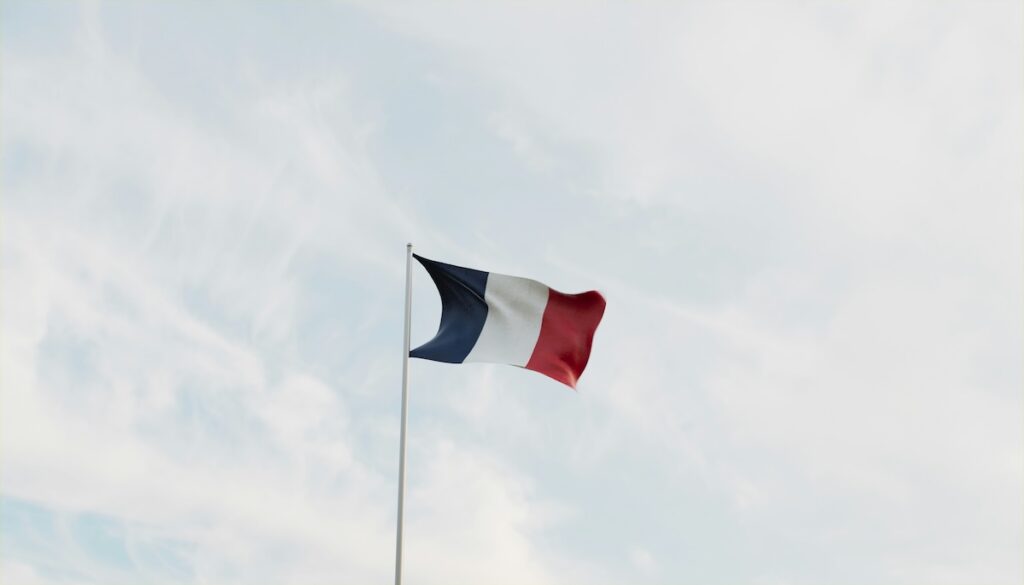
Versailles Abandoned: The Revolutionary Period
After the royal family’s forced departure, Versailles stood mostly empty, its future uncertain. Revolutionary leaders decided not to destroy the palace, recognizing its artistic value, but much of its furniture was sold at auction to raise money for the revolutionary government.
The magnificent gardens were neglected, fountains stopped working, and parts of the palace fell into disrepair.
During the revolutionary period, some parts of Versailles were repurposed. The palace briefly served as a storehouse for art confiscated from churches and aristocratic homes. Some of the outlying buildings became hospitals or manufacturing workshops. The revolutionary government considered turning the main palace into a museum, a school, or even demolishing it entirely, but lack of money prevented any major changes.
Napoleon Bonaparte, who took power in France after the revolution ended, considered using Versailles as his imperial residence but decided it would be too expensive to maintain and too closely linked with the overthrown monarchy. Instead, he removed many of the remaining artworks to furnish his own palaces, particularly the Tuileries and Fontainebleau.
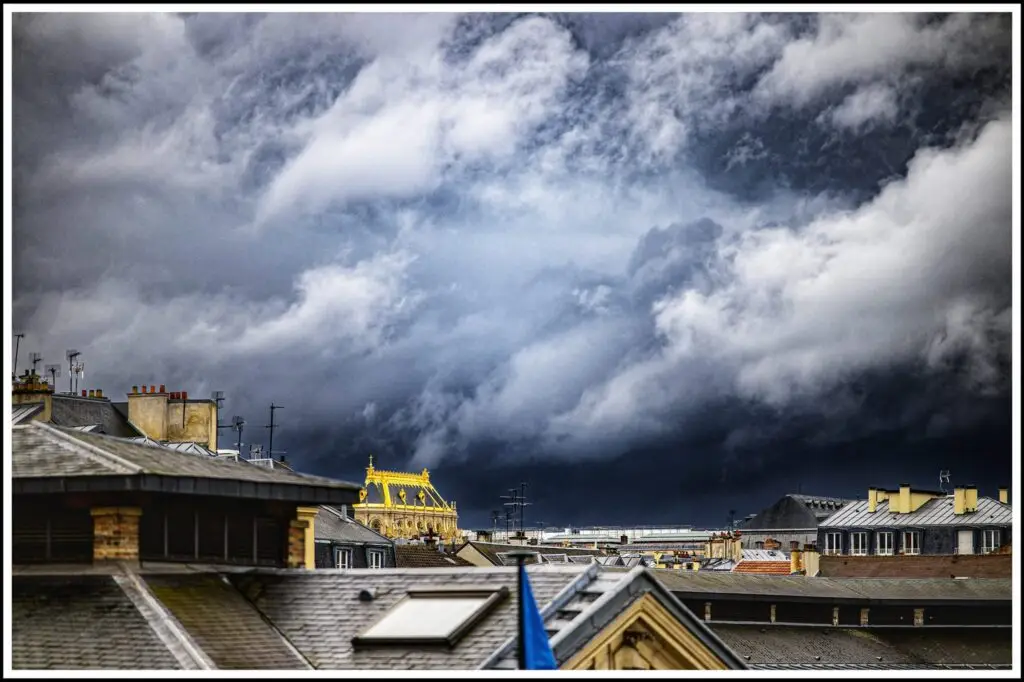
Versailles Reborn: From Royal Palace to National Museum
It wasn’t until the 1830s that King Louis-Philippe, who came to power after France’s 1830 revolution, decided to save Versailles by transforming it into a museum dedicated to “all the glories of France.” This project saved the most famous rooms, like the Hall of Mirrors and the royal apartments, while converting many others to display paintings of important figures and events in French history.
Louis-Philippe’s decision saved Versailles from further decay and established its new role as a place where all French citizens could learn about their nation’s past. The Museum of the History of France officially opened at Versailles in 1837, marking the beginning of the palace’s transformation from a symbol of royal power to a shared national treasure.
In 1871, after France lost the Franco-Prussian War, Versailles became important again. On January 18, 1871, the German Empire was declared in the Hall of Mirrors. Later that year, the French government moved to Versailles for a short time while Paris recovered from the war and a major uprising.
The Hall of Mirrors became important in history again on June 28, 1919, when world leaders signed the Treaty of Versailles there, officially ending World War I. The French chose this room on purpose because, 48 years earlier, the German Empire had been declared there, which had embarrassed France. This was their way of taking back their pride.
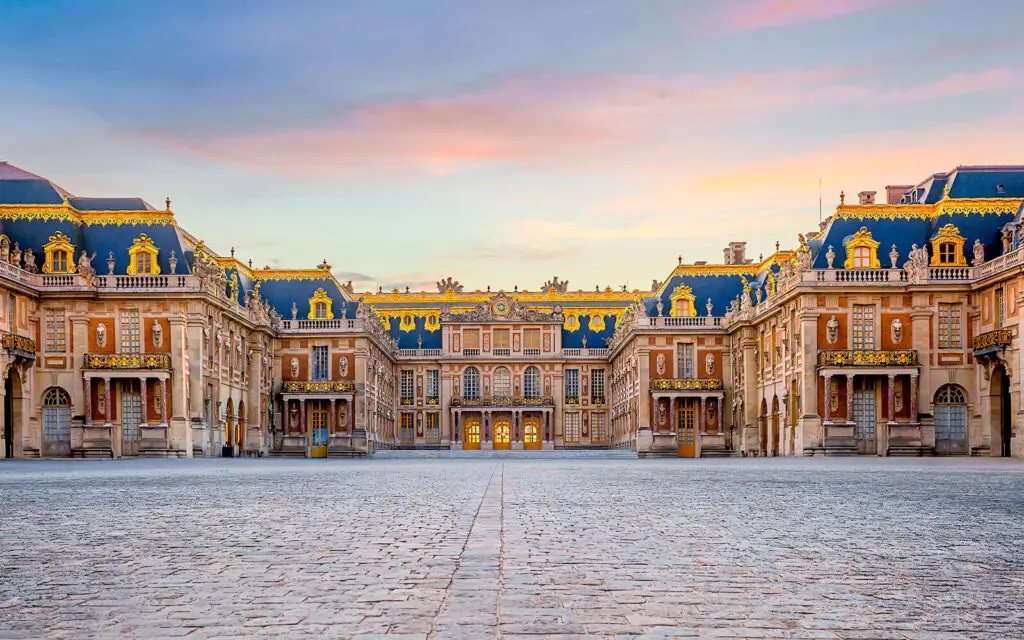
Versailles Today: UNESCO World Heritage Site
Today, the Palace of Versailles is one of the world’s greatest historical treasures. In 1979, UNESCO declared Versailles a World Heritage Site, recognizing its importance to human history and culture. The palace welcomes nearly 10 million visitors annually, making it one of the most visited places on Earth.
Many renovation projects have returned much of the palace and gardens to their former glory. Visitors can now walk through the same rooms where kings once ruled, admire the spectacular Hall of Mirrors where history was made, and explore the magnificent gardens that once amazed visitors from around the world.
The palace regularly hosts art exhibitions, concerts, and special events. During summer months, the gardens feature fountain shows set to music, recreating the shows that once entertained kings and queens. Sound and light shows project images onto the palace façade, bringing its history to life.
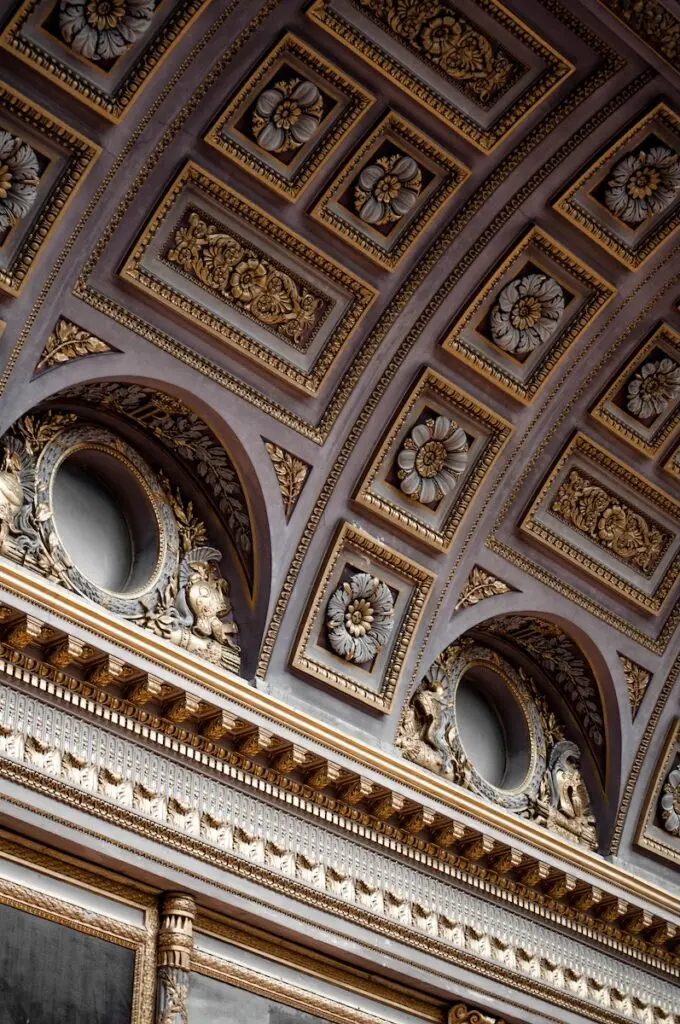
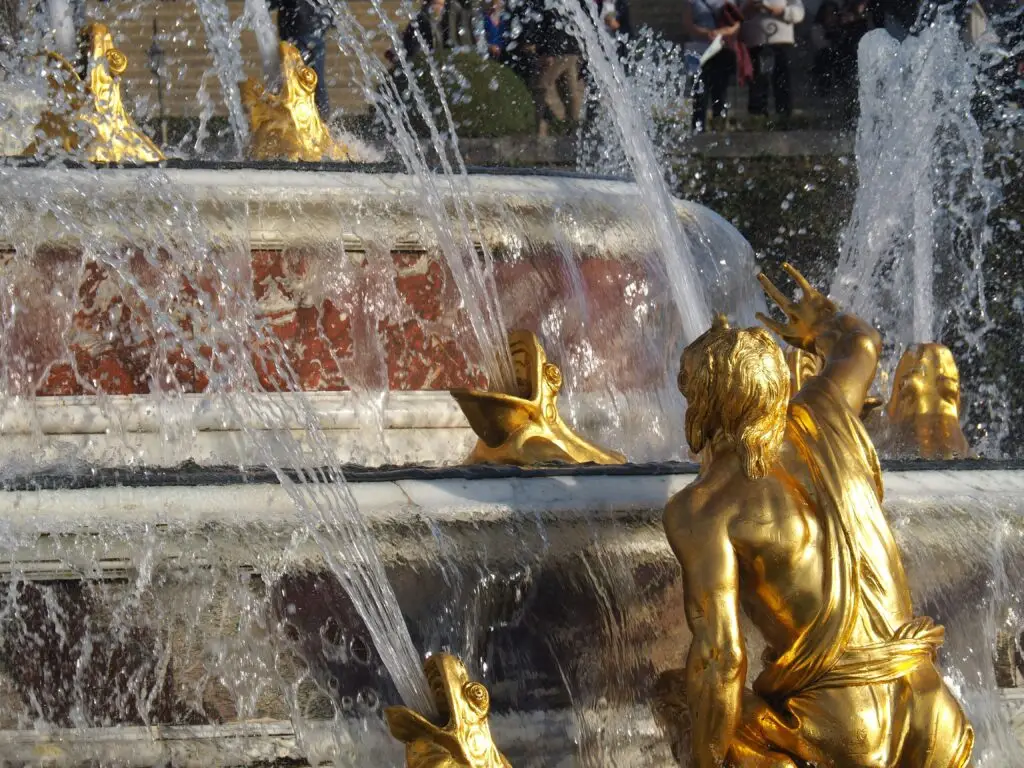
The Coolest Things About Versailles!
The Palace of Versailles wasn’t just any old palace – it was the biggest and fanciest palace in all of Europe! Let’s explore some of its coolest parts together.
Amazing Rooms and Special Places
The Hall of Mirrors: Imagine a hallway longer than your school gymnasium with 357 mirrors covering the walls! Back in the 1680s, mirrors were super expensive – only special craftspeople in Venice (that’s in Italy) knew how to make them. But King Louis XIV’s clever minister found a way to make mirrors in France too!
When the king had parties, they would light thousands of candles that would reflect in all the mirrors, making the whole room sparkle like it was full of stars. Can you imagine walking through a room like that without smartphones or electricity? It must have seemed like magic!
The Royal Chapel: The king’s special church took 21 years to build! It stands as tall as a 13-story building and has the most beautiful paintings on the ceiling. If you visited, you’d get a sore neck from looking up at all the colorful pictures of angels and clouds. The king and all his fancy nobles would go to church here every single morning.
The Grand Canal: This isn’t like a regular canal – it’s a giant cross-shaped lake that’s over a mile long! King Louis loved playing with boats here. He had tiny versions of real warships and special boats called gondolas from Venice. The gondolas came with their own Italian gondoliers (that’s a fancy word for “boat drivers”) who would sing while they moved the boats. Sometimes they even had pretend sea battles for fun! In winter when it froze over, people would ice skate on it!
The Orangery: The Orangery was like a giant greenhouse where they kept over 1,200 orange trees when it got cold outside. The clever designers built special heaters under the floor and made all the windows face south to catch the sunshine. Can you believe they could keep orange trees alive during freezing winters without modern heaters? When summer came, they would have a big parade to move all the trees outside to the garden.
The Elephant at Versailles! One of the most exciting things at Versailles was the king’s zoo called the Menagerie. In 1668, the King of Portugal sent King Louis XIV an actual elephant as a present! Can you imagine getting an elephant as a gift? This elephant was super famous – everyone at the palace wanted to see it. Artists made paintings of it, and people would travel from far away just to look at this amazing animal.
Sadly, when the elephant died in 1681, scientists studied its body to learn more about elephants since most French people had never seen one before. Its bones were kept in a museum in Paris where people can still learn about this special elephant today!
The Royal Stables: The king’s horses lived better than most people! The Royal Stables could fit about 600 horses and looked like palaces themselves, with beautiful stone carvings and grand entrances. Hundreds of people worked just to take care of these horses. The king and nobles would also use the stables for fancy horse shows where the horses would dance to music!

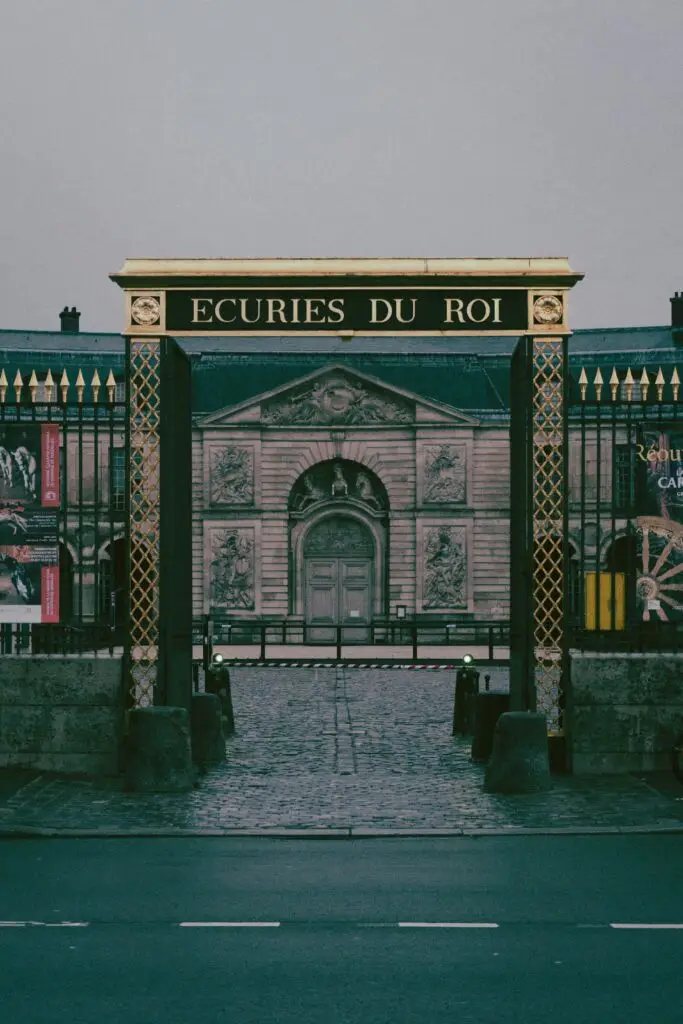
Big Events That Happened at Versailles
America’s Big Moment (1783): Did you know the United States became an official country at Versailles? After the American Revolutionary War (when America fought to be free from Britain), important leaders signed special papers at Versailles that said “America is now a real country!” France was one of the first countries to say “Welcome to the world, USA!”
The First Flying Animal Passengers (1783): In the same year, two brothers named Montgolfier came to Versailles with something nobody had seen before – a hot air balloon! The king and queen watched as they put a sheep, a duck, and a rooster in a basket under the balloon and sent them flying into the sky. These animals were the first living creatures to fly in a hot-air balloon, and everyone was amazed when they landed safely!
The Tennis Court Promise (1789): Something very important for France happened at the royal tennis court (not like our tennis courts today – it was a different game). A large group of people who wanted to make France fairer for everyone made a special promise. They all raised their hands and promised not to leave until they created new rules for how France should be run. This was one of the first big moments of the French Revolution.
The Hungry Women’s March (1789): One day, almost 7,000 women walked all the way from Paris to Versailles in the rain because they were hungry and couldn’t find bread to feed their families. They were very angry at the king and queen for having so much food at the palace while regular people were starving. These brave women made the royal family pack their bags and come back to Paris. After this, no king or queen ever lived in the Versailles castle again!
The End of World War I (1919): Many years later, after World War I involved countries all around the world, important leaders met in the Hall of Mirrors to sign a special agreement to end the fighting. This famous Treaty of Versailles was signed on June 28, 1919. They chose this beautiful room on purpose to show how important this moment was for history.
Super Cool Facts About Versailles
- The Palace of Versailles has 700 rooms! If you spent just 1 minute in each room, it would take you almost 12 hours to see them all!
- There are 1,250 fireplaces in the palace. Imagine having to light all those fires to keep warm in winter!
- The garden has 50 amazing fountains with 620 water jets that can shoot enough water to fill 7 swimming pools every hour!
- Poor King Louis XIV had terrible toothaches and had ALL his teeth pulled out by age 40. Maybe that’s why he never smiles in his pictures!
- Even though the palace was super fancy, it had no toilets! Sometimes, people would just go to the bathroom in corners or behind curtains…
- When the king had dinner, the royal chefs prepared 113 different dishes for each meal! That’s like having 113 different choices at a restaurant, but the king usually only ate a few of his favorites.
- The palace gardens have more trees than Central Park in New York City – about 200,000! And gardeners plant more than 210,000 flowers every year.
- It takes 80 full-time gardeners working every day to keep the gardens looking beautiful.
- If you walked around the entire palace grounds, you’d walk more than 8 miles! It’s bigger than 1,500 football fields put together!
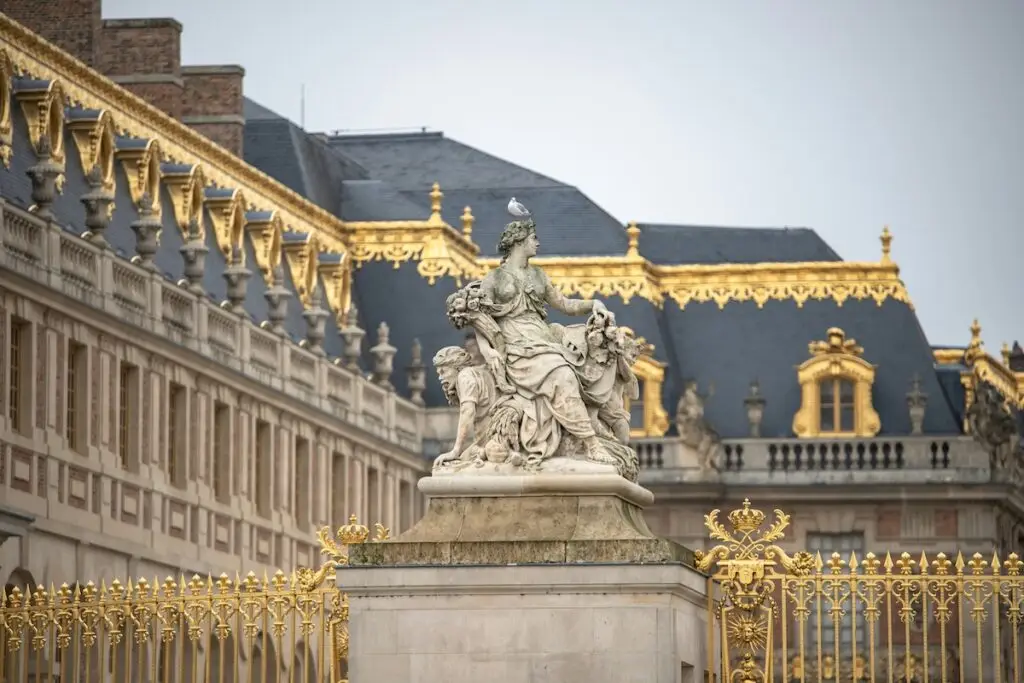
A History of Versailles for Kids: Visiting Today
If you’re planning to visit the Palace of Versailles with your family, here are some helpful tips:
- Purchase tickets online in advance to avoid long lines, especially during summer months.
- Consider renting bicycles to explore the gardens—they’re too large to cover entirely on foot.
- The best time to see the musical fountain shows is on weekends from April to October.
- Download the official Palace of Versailles app for interactive maps and kid-friendly guided tours.
- Pack a picnic to enjoy by the Grand Canal, just as visitors have done for centuries.
- Visit the royal stables (Grande Écurie and Petite Écurie), which now house the National Equestrian Academy and frequently offer impressive horsemanship demonstrations.
- Don’t miss Marie Antoinette’s Estate, including the Petit Trianon and the Queen’s Hamlet, which offer a peaceful contrast to the grandeur of the main palace.
The Palace of Versailles continues to inspire wonder and amazement just as it did when it was first built—a magnificent reminder of history that connects us to the past while remaining vibrant in the present.
